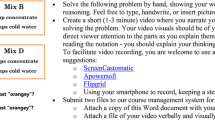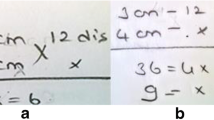ABSTRACT
In this study, we developed an instrument for assessing teachers’ mathematics content knowledge (MCK) on ratio and proportion and examined the profile of Indonesian primary teacher’s MCK on this topic. The MCK items were administered to 271 Indonesian in-service primary teachers with a variety of educational backgrounds and teaching experiences. Teachers’ responses were analyzed by factor analysis and cluster analysis. The MCK instrument was found to have good acceptability in the reliability analysis with 3 factor components—meaning of proportional and non-proportional situations, number structures in situation, and figural representation—which was the main result of the study. With respect to the 3 factors, the teachers in the 3 assigned categories (“Good,” “Middle,” or “Low”) showed consistent performance on the items of the 3 factors. In particular, our results indicated that Indonesian in-service primary teachers had difficulty with the factor on figural representation, but they performed best on number structures in situation representing products of proportional reasoning.
Similar content being viewed by others
References
Ahl, V. A., Moore, C. F. & Dixon, J. A. (1992). Development of intuitive and numerical proportional reasoning. Cognitive Development, 7, 81–108.
Alatorre, S., & Figueras, O. (2005). A developmental model for proportional reasoning in ratio comparison tasks. In H. L. Chick, H. L. & J. L. Vincent, (Eds.), Proceeding of the 29th conference of the International Group for the Psychology of Mathematics Education, Vol. 2 (pp. 25–32). Melbourne: PME.
Ball, D. L., Hill, H. C., & Bass, H. (2005). Knowing mathematics for teaching: who knows mathematics well enough to teach third grade, and how can we decide? The fall 2005 issue of American Educator, the quarterly Journal of the American Federation of Teachers, AFL-CIO.
Barret, J. (2002). Working with novice teachers: Challenges for professional development mathematics. Teacher Education and Development Journal, 4, 15–27.
Barrett, J., Jones, G., Mooney, E., Thornton, C., Cady, J. & Guinee, P., et al. (2002). Working with novice teachers: challenges for professional development. Mathematics Teacher Education and Development, 4, 15–27.
Bayazit, I. (2013). Quality of the tasks in the new Turkish elementary mathematics textbooks: The case of proportional reasoning. International Journal of Science and Mathematics Education, 11, 651–682.
Beaton, D., Bombardier, C. & Ferraz, M. (2000). Guidelines for the process of cross-cultural adaptation of self-report measures. Spine, 25(24), 3186–3191.
Behr, M., Harel, G., Post, T. & Lesh, R. (1992). Rational number, ratio and proportion. In D. Grouws (Ed.), Handbook of research on mathematics teaching and learning (pp. 296–333). NY: Macmillan Publishing.
Ben-Chaim, D., Fey, J. T., Fitzgerald, W. M., Benedett, O. C. & Miller, J. (1998). Proportional reasoning among 7th grade students with different curricular experiences. Educational Studies in Mathematics, 36, 247–273.
Blömeke, S. & Delaney, S. (2012). Assessment of teacher knowledge across countries: A review of the state of research. ZDM, 44(3), 223–247.
Brink, J. V. D. & Streefland, L. (1979). Young children (6–8)-ratio and proportion. Educational Studies in Mathematics, 10, 403–420.
Chaim, D. B., Keret, Y., & Ilany, B. (2007). Designing and implementing authentic investigative proportional reasoning tasks: the impact on pre-service mathematics teachers’ content and pedagogical knowledge and attitudes. Journal of Mathematics Teacher Education, 10, 333–340
Chaim, D. B., Keret, Y. Z. & Ilany, B. S. (2012). Research and teaching in mathematics teachers’ education: Pre- and in-service mathematics teachers of elementary and middle school classes. Rotterdam: Sense.
Coakes, S. J. & Steed, L. G. (1997). SPSS analysis without anguish. Brisbane: John Wiley and Sons.
Dole, S. (2008). Ratio tables to promote proportional reasoning in the primary classroom. Australian Primary Mathematics Classroom, 13(2), 19–22.
Ebel, R. L. & Frisbie, D. A. (1986). Essentials of educational measurement. Englewood Cliffs: Prentice-Hall.
Entwistle, N., Tait, H., & McCune, V. (2000). Patterns of response to an approaches to studying inventory across contrasting groups and contexts. European Journal of Psychology of Education, 15(1), 33–48.
Fennema, E. & Franke, M. (1992). Teachers’ knowledge and its impact. In D. A. Grouws (Ed.), Handbook of research on mathematics teaching and learning. NY: Macmillan.
Fischbein, E. (1994). Tacit models. In D. Tirosh (Ed.), Implicit and explicit knowledge: An educational approach (pp. 96–110). Norwood: Ablex.
Hair, J. F., Jr., Anderson, R. E., Tatham, R. L. & Black, W. C. (1998). Multivariate data analysis (5th ed.). Upper Saddle River: Prentice-Hall.
Hart, K. M. (1981). Ratio and proportion. In K. M. Hart (Ed.), Children’s understanding of mathematics: 11–16. The CSMS Mathematics Team (pp. 88–101). London: John.
Ilany, B-S., Keret, Y., & Ben-Chaim, D. (2004). Implementation of a model using authentic investigative activities for teaching ratio & proportion in pre-service teacher education. Proceedings of the 28th Conference of the International Group for the Psychology of Mathematics Education, 3, 81–88.
Krauss, S., Baumert, J., & Blum, W. (2008). Secondary mathematics teachers’ pedagogical content knowledge and content knowledge: validation of the COACTIV constructs. ZDM Mathematics Education, 40, 873–892.
Krauss S., Blum, W., Brunner, M., Neubrand, M., Baumert, J., Kunter, M., …, Elsner. J. (2013). Mathematics teachers’ domain specific professional knowledge: Conceptualization and test construction in COACTIV. In Kunter, M., Baumert, J., Blum, W., Klusmann, U., Krauss, S., Neubrand, M. (Eds.) 2013, VI, 378 p 31. Mathematics Teacher Education 8. NY: Springer Science + Business Media.
Lamon, S. (1993). Ratio and proportion: Connecting content and children’s thinking. Journal for Research in Mathematics Education, 24(1), 41–61.
Lamon, S. J. (2007). Rational and proportional reasoning: Toward a theoretical framework for research. In F. K. Lester (Ed.), Second handbook of research on mathematics teaching and learning (Vol. 1, pp. 629–668). Charlottes: Information Age.
Lawton, C. (1993). Contextual factors affecting errors in proportional reasoning. Journal for Research in Mathematics Education, 24(5), 460–466.
Lesh, R., Post, T. & Behr, M. (1988). Proportional reasoning. In J. Hiebert & M. Behr (Eds.), Number concepts and operations in the middle grades (pp. 93–118). Hillsdale: Lawrence Erlbaum Associates/National Council of Teachers of Mathematics.
Livy, S. & Vale, C. (2011). First year pre-service teachers’ mathematical content knowledge: Methods of solution for a ratio question. Mathematics Teacher Education and Development, 13(2), 22–43.
Ma, L. (1999). Knowing and teaching elementary mathematics: Teachers’ understanding of fundamental mathematics in China and the United States. NJ: Lawrence Erlbaum Associates.
Margarit, J., & Figueras, O. (2001) Ratio comparison: Performance on ratio in similarity tasks. Utrecht Netherlands: PME Conference Proceeding paper.
Masters, J. (2012). Eight grade in-service teachers’ knowledge of proportional reasoning and functions: A secondary data analysis. International Journal for Mathematics Teaching & Learning [Published only in electronic form].February 3rd Issue. Retrieved from http://www.cimt.plymouth.ac.uk/journal/masters.pdf.
Peled, I. & Hershkovitz, S. (2004). Evolving research of mathematics teacher educators: The case of non-standard issues in solving standard problems. Journal of Mathematics Teacher Education, 7, 299–327.
Schmelzing, S., Driel, J. H. V., Juttner, M., Brandenbusch, S., Sandmann, A. & Neuhaus, B. J. (2013). Development, evaluation and validation of a paper-and-pencil test for measuring two components of biology teachers’ pedagogical content knowledge concerning the “cardiovascular system”. International Journal of Science and Mathematics Education, 11(6), 1369–1390.
Schmidt, S. H., Houang, R. & Cogan, L. S. (2011). Preparing future math teachers. Science, 332, 1266–1267.
Senk, S. L., Peck, R., Bankov, K., & Tatto, M. T. (2008). Conceptualizing and measuring mathematical knowledge for teaching: Issues from TEDS-M, an IEA cross-national study. Mexico: 11th International Congress of Mathematics Education.
Shulman, L. (1986). Those who understand: Knowledge growth in teaching. Educational Researcher, 15(2), 4–14.
Thompson, B. & Levitov, J. E. (1985). Using microcomputers to score and evaluate test items. Collegiate Microcomputer, 3, 163–168.
Thomson, S. & Fleming, N. (2004). Summing it up: Mathematics achievement in Australian schools in TIMSS 2002. Melbourne: Australian Council for Educational Research.
Tirosh, D. & Graeber, A. O. (1990). Evoking cognitive conflict to explore pre-service teachers’ thinking about division. Journal for Research in Mathematics Education, 21(2), 98–108.
Tourniaire, F. & Pulos, S. (1985). Proportional reasoning: A review of the literature. Educational Studies in Mathematics, 16(2), 181–204.
Wiersma, W. & Jurs, S. G. (1990). Educational measurement and testing (2nd ed.). Boston: Allyn and Bacon.
Author information
Authors and Affiliations
Corresponding author
Electronic supplementary material
Below is the link to the electronic supplementary material.
ESM 1
(DOCX 141 kb)
Rights and permissions
About this article
Cite this article
Ekawati, R., Lin, FL. & Yang, KL. DEVELOPING AN INSTRUMENT FOR MEASURING TEACHERS’ MATHEMATICS CONTENT KNOWLEDGE ON RATIO AND PROPORTION: A CASE OF INDONESIAN PRIMARY TEACHERS. Int J of Sci and Math Educ 13 (Suppl 1), 1–24 (2015). https://doi.org/10.1007/s10763-014-9532-2
Received:
Accepted:
Published:
Issue Date:
DOI: https://doi.org/10.1007/s10763-014-9532-2




